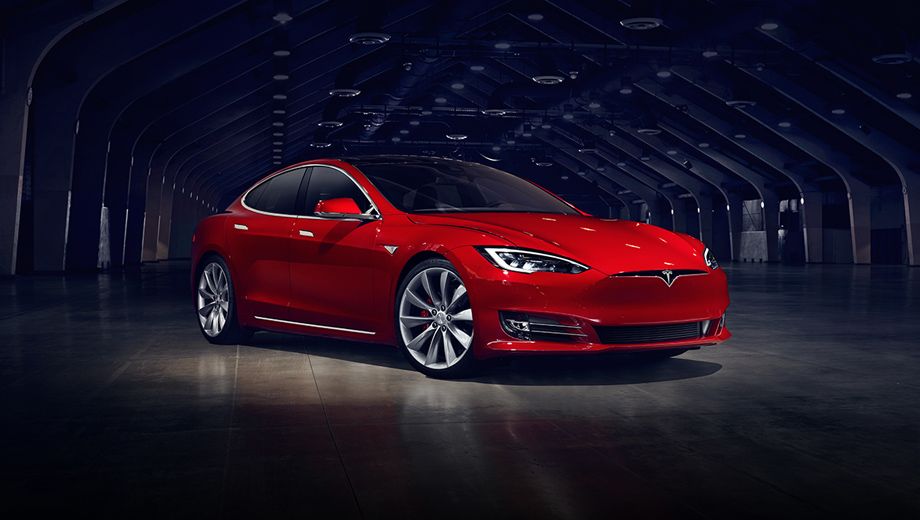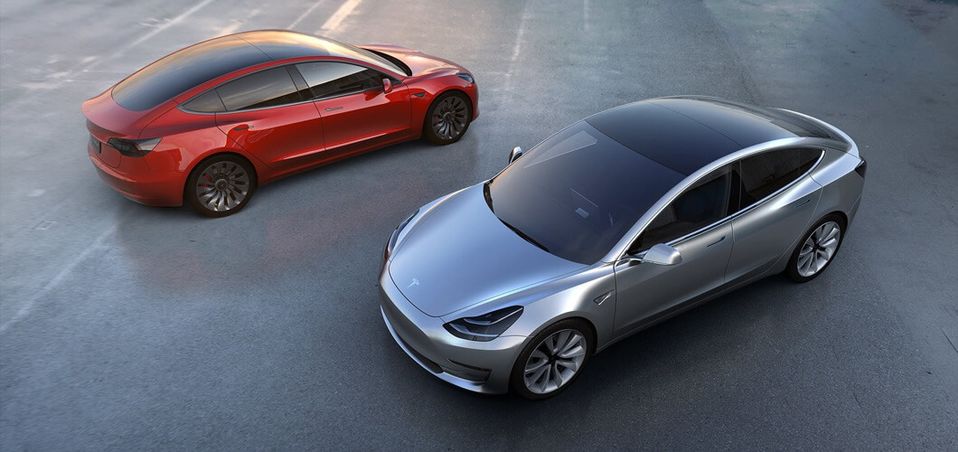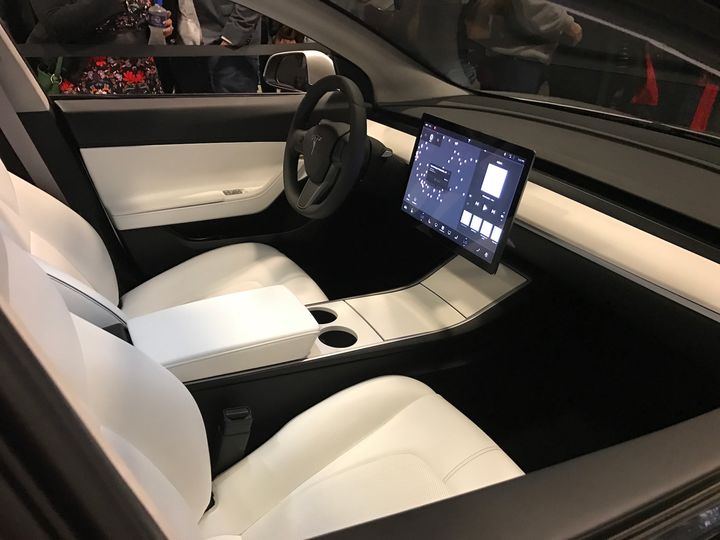Tesla's new Model 3 will boast a long 500km range and a low A$70,000 price tag.
Both numbers come from the very top of the EV manufacturer: founder and CEO Elon Musk.
Musk outlined the range on a single charge at the unveiling of the Model 3 this weekend, which sets a jaw-dropping new benchmark for an electric car.
Also in the jaws-hit-the-floor category is the Australian pricing promised by Musk in a tweet last week, who said it could cost "$US price in $AUD plus import duties and sales tax." Based on the US$44,000 long-range version of the Model 3, that should see the local sticker come in just shy of $70,000.
Based on the same Musk-endorsed formula, the entry-level Model 3 with its 350km range and US$35,000 tag would land here at just a little over $50,000.
However, Tesla Australia has not yet detailed which of the Model 3 variants will be sold locally.
Tesla has taken more than 500,000 deposits at a US$1,000 a piece, Musk said during the a launch event as Tesla's plant in Fremont, California – creating a daunting backlog that could take more than a year to fulfill
“We finally have a great, affordable, electric car,” Musk said. “I’m really confident this will be the best car in this price range, hands down. Judge for yourself.”
Two battery versions
Tesla has simplified the manufacturing process “dramatically,” Musk said.
The same factory space where Tesla can build 50,000 Model S or Model X cars, it will soon be able to produce 200,000 Model 3s. Part of that is due to a simplified package of options. The car comes in two battery types: standard and extended range.
The standard battery model, priced from US$35,000, has an estimated range of 355km (220 miles), with 30 minutes hooked up to one of Tesla's supercharge stations providing enough juice for a 210km (130 miles) trip. This Tesla 3 will leap from zero to 100km/h in 5.6 seconds.
The extended range battery model, priced from US$44,000, tops out at 500km (310 miles), with a 30 minute supercharge session good for 270km (170 miles) – equivalent to the Tesla Model S – and clocking zero to 100km/h in 5.1 seconds.
Only two other electric cars in the world have broken the 300-mile range barrier: the most expensive versions of Tesla’s Model S and Model X, which are ultra-luxury cars that cost US$100,000 or more.
Unlike previous cars, Tesla didn’t disclose the size of its two Model 3 battery packs.
All cars will be identical from the outside, with no additional badging indicating battery size or premium options. The plan is for the Model S and X to eventually do the same.
The US$35,000 standard Model 3 version won’t be available until Fall. The longer-range version is available now for the thousands of Tesla employees who placed reservations last year.
A US$5,000 premium options package includes an all-glass roof, open-pore wood decor, premium sound, heated seats, and premium seat materials.
We drove the Model 3
The Model 3 is elegant inside and out, and in ways that are difficult to appreciate from the photos.
I was allowed to drive one before the event. It’s not as fast as the more expensive Model S – the quickest production car in the world – but the steering is tight and it feels somewhat lighter on its feet because of its smaller footprint and lighter battery.
The glass-roofed interior feels like a mini-atrium, and the touch screen is bright and intuitively laid out.
There were a few technological surprises. The ventilation system is a marvel, stretching in one long strip that spans the front seat. The touch screen allows both the driver and the passenger to instantly direct a wide flow of air wherever they want it.
The scrolling dials on the steering wheel move in all four directions and allow you to adjust everything from the side windows to the music playlist.
Some of the executives responsible for the Model 3 have been there from the beginning, leading Tesla from a tiny upstart to an icon of automotive desire. Chief Technology Officer JB Straubel was the battery architect behind the original Tesla Roadster. Chief Designer Franz von Holzhausen designed the company’s three most vaunted accomplishments: the Model S, Model X, and Model 3.
“The interior is nothing like any other car out there,” said von Holzhausen. “When you get in the car, how does it feel? When you see the car, how does it make you feel? When you drive the car, what does it inspire in you?”
The curse of the S curve
Despite these achievements, Musk sounded grave about the road ahead. “The biggest challenge that we face here is ‘S Curve’ manufacturing,” he said, describing a ramp up of production that starts slow, then increases dramatically before tapering off. “That ‘S’ portion is us going through hell, basically.”
The Model 3 is an all-new auto platform for Tesla, with a new motor technology and a new battery architecture.
The car is designed for ease of manufacturing, and even the dashboard is completely void of knobs, dials, and gauges.
Almost everything is controlled with the car’s single 15-inch touchscreen, which accepts inputs from voice commands and two control knobs on the steering wheel.
Musk reiterated his projections of a very slow start in the next few months and then ramping up rapidly to a rate of 20,000 a month by the end of the year, and 50,000 a month by the end of 2018. It’s an aggressive schedule that will more than double Tesla’s total production rate in six months, and then quintuple it by the end of next year.
“I have high confidence that we’ll get to the end of the ‘S Curve,’ but it is impossible to predict the shape of it,” Musk said.
The challenge ahead
The key challenge, of course, is making all of these cars quickly enough and without the problems that plagued the launch of its more complicated Model X.
Tesla aims to make 500,000 cars a year in 2018 and is counting on its battery factory under construction near Reno, Nevada, to drive down battery costs. Both the Gigafactory and the Fremont factory have showers, and some employees have sleeping bags, in anticipation of the long nights ahead.
Tesla’s “master plan” - a blog post laid out by Musk in August 2006 – was to enter the auto industry at high-end prices, then drive down-market as fast as possible with increasingly higher volumes.
The Model 3 is the Palo Alto, California-based company’s fourth car, after the Roadster sports car, the Model S sedan, and the Model X sport utility vehicle.
If the Model 3 is successful, it would signal the completion of the Master Plan and a new era of electrification for the auto industry. “This is a great day for Tesla,” Musk said. “It’s something that we've been working for since the beginning of the company.”
Additional material by David Flynn





13 May 2016
Total posts 31
Can't wait to see more of these cars on the road!
Singapore Airlines - The PPS Club
16 Jun 2017
Total posts 35
"Model S – the quickest production car in the world". I think you might get a few arguments about that
Qantas - Qantas Frequent Flyer
27 Jul 2016
Total posts 56
in Ludicrous mode I believe it is: 0-60 mph in 2.5 seconds.
Qantas - Qantas Frequent Flyer
10 Dec 2014
Total posts 58
@plad it actually is.
09 Jan 2016
Total posts 43
'low A$70,000 price tag'. Still out of reach of 99% of the popultion.
Qantas - Qantas Frequent Flyer
28 Dec 2011
Total posts 95
Elon Musk has said that the price would be the same around the world. So in it's cheap[est form it would cost $44000, and the long range model would come in at $55000.
13 Sep 2016
Total posts 55
This is what we need, more electric cars at more affordable prices, oh and for the Govt to ditch any tax on them apart from the 10% GST and maybe even offer a rebate to encourage people to buy more EVs.
Qantas - Qantas Frequent Flyer
10 Dec 2014
Total posts 58
I can't wait to try it. Reviews in the US are very positive - Motor Trend said that the ride makes the Alfa Romeo Giulia feel like a "wet sponge" in comparison.
Singapore Airlines - The PPS Club
16 Jun 2017
Total posts 35
Does anyone know what it costs to charge these cars, given we in SA we have the highest electricity prices in the country.
Hi Guest, join in the discussion on Tesla Model 3: 500km range, $70,000 price tag?